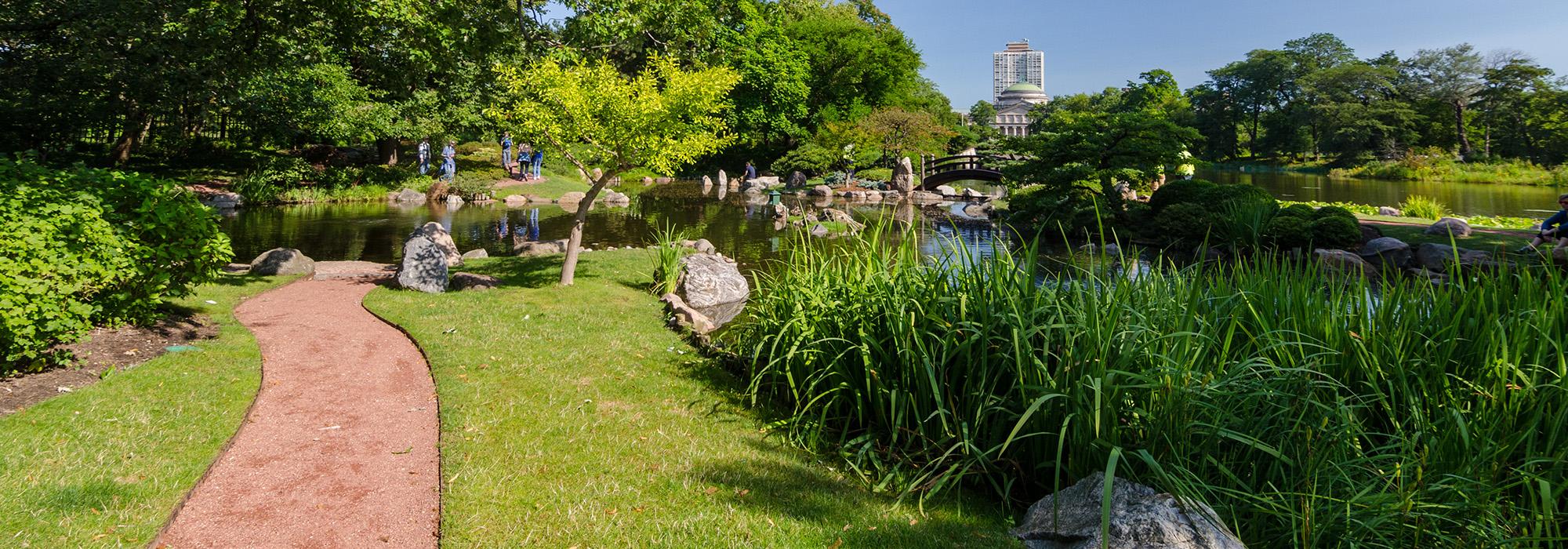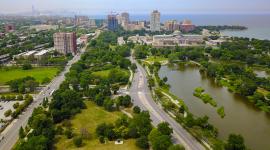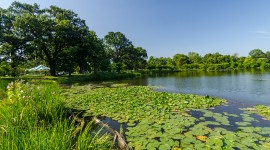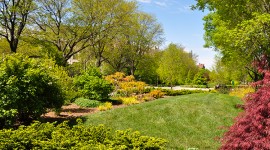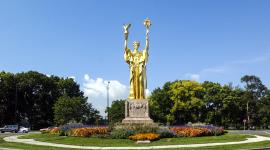Obama Presidential Center Rhetoric Heats Up

The debate over the Obama Presidential Center (OPC) proposed for Chicago’s historic Jackson Park has heated up with the publication of the latest column by Chicago Tribune architecture critic Blair Kamin: Obama center plans won't destroy Olmsted's park — they should be improved, not rejected. The column was in response to an opinion piece by The Cultural Landscape Foundation’s (TCLF) President & CEO, Charles A. Birnbaum, published in the London-based international design publication Dezeen. Jackson Park, which was originally designed in 1871 by Frederick Law Olmsted, Sr., and Calvert Vaux (famed for New York City’s Central Park), redesigned by Olmsted in 1892 and by Olmsted, Olmsted & Eliot in 1895, is part of Chicago’s South Park system and is listed in the National Register of Historic Places. Some twenty acres of the park have been confiscated for the construction of the OPC.
In the opening two paragraphs of his column, Mr. Kamin cites opponents of the OPC as “painting the project as a self-indulgent statement by former President Barack Obama” and then quotes TCLF’s Birnbaum as saying: “There is no need to destroy one significant cultural legacy in order to celebrate another.”
Deliberate or not, the implication of the column’s introduction is that TCLF is one of the “opponents painting the project as a self-indulgent statement.” This is grossly misleading and misrepresentative of TCLF’s position.
Here, again, is TCLF’s position, which has been articulated repeatedly for more than three years: TCLF is not opposed to the Obama Presidential Center on Chicago’s South Side. However, TCLF does not support the confiscation of parkland held in public trust—whether in Jackson, Washington, or other parks. The University of Chicago, which orchestrated the winning bid, owns land on the South Side that they should use for the purpose—they should not ask residents to sacrifice parkland. In addition, the City of Chicago owns land that could be developed for the purpose, rather than sacrificing parkland.
Some further observations:
- “Birnbaum and other opponents of the Jackson Park site … are ignoring how the Obama plans would improve a scruffy landscape that is poorly maintained, brutally interrupted by a wide road, and seriously underutilized as a result.” Let’s break this down: “poorly maintained” is not the fault of the park. Perhaps a park conservancy should be formed, like the one for Central Park and others, that would maintain the park. Indeed, perhaps there should be a conservancy for the entire South Park system, including Washington Park and the Midway Plaisance. “Brutally interrupted by a wide road”—the road placement is original to the park, but it has been widened from two to six lanes. A comprehensive plan for the park, rather than the current piecemeal approach, could address roadways in a holistic fashion. “Seriously underutilized”—see the remarks above about a conservancy, which could maintain and program the park;
- The opponents “also fail to recognize, as Olmsted did, that parks need to evolve with changing circumstances rather than remain rigidly fixed.” This is about managing change and continuity at a historic park, something TCLF talks about with great frequency. Absent comprehensive master planning, decision-making is hamstrung by a lack of knowledge and understanding of the park;
- “At worst, the opponents are imposing a narrow aesthetic perspective on plans that promise to be an economic boon—and an enormous source of pride—for African-Americans who have long suffered from racial discrimination and the under-investment that accompanied it.” Again, as with the opening paragraph, opponents are being painted with a broad brush. TCLF has challenged the placement of the OPC in Jackson Park and has discussed how the tower, in particular, is inappropriate. TCLF has not taken on the role of critics of Williams & Tsien's design;
- “Like those fighting the Jackson Park site, I would have preferred if Obama had chosen a parcel on the edge of nearby Washington Park that the University of Chicago made available as an alternative.” TCLF never supported the idea of placing the OPC in Washington Park; indeed, nearly three years ago TCLF published an open letter to Pres. & Mrs. Obama in the Huffington Post specifically asking them not to take part of Washington Park;
- “To the east of the center’s buildings, the foundation plans about 5 acres of new parkland, courtesy of a bold urban design stroke: The closure of six-lane Cornell Drive, which cuts this section of the park into isolated patches of greenery.” This is double counting—Cornell Drive is mapped parkland that has been substantially widened from two to six lanes. (See item #2, above, concerning planning for Cornell Drive);
- “The notion that these moves would destroy Jackson Park is ludicrous. Even a respected Olmsted scholar whom I consulted said so.” “There’s going to be a hell of a lot of investment in this part of the park. That’s a real positive,” David Schuyler, a Franklin & Marshall College professor who has co-edited a collection of Olmsted’s papers said during a telephone interview last week. “And if (the center) draws people to this part of the park, it means that the city’s going to maintain it, which it hasn’t been doing very much lately. So, as far as I can tell, it’s a real trade-off with a very positive effect as well.” We don't know what Schuyler knew about the OPC in Jackson Park before his conversation with Mr. Kamin, nor do we know what information and context Mr. Kamin did or did not provide, so it’s hard to assess this observation. TCLF can, however, point to the comments provided by the National Association for Olmsted Parks concerning the “adverse effects” the OPC would have on Jackson Park;
- “The severe, obelisk-like tower remains the rub. Schuyler said he found its height and bulk 'a bit scary.'” This underscores TCLF’s position about the inappropriateness of the tower in the park;
- “City officials also should give their answer to the Cultural Landscape Foundation’s charge that the Obama center would amount to a 'confiscation' of public space.” The city gave away some twenty acres of parkland held in public trust to the OPC rather that require the University of Chicago, which orchestrated the winning bid, to use university-owned land and/or vacant city land. That seems like confiscation;
- “Olmsted, a beloved figure whose masterpiece is New York’s Central Park, looms over the entire process. Olmsted scholars say the landscape architect generally objected to the insertion of large structures in his parks. On the other hand, he was a passionate abolitionist who might have appreciated the symbolic importance of Obama’s story and accepted the need to accommodate a major new feature in his park. In the end, it’s impossible to know.” This is a highly speculative paragraph with an accurate ending – “In the end, it’s impossible to know”;
- “What we do know is that Olmsted was a pragmatist, not an ideologue. He embraced the need to adapt his parks to changing times and circumstances. After the Chicago world’s fair of 1893, for example, he made a portion of his naturalistic landscape more formal to accommodate the Beaux-Arts fair building that is now the Museum of Science and Industry.” Correct: that was part of his 1895 plan to heal the park following the World’s Columbian Exposition. Significantly, in a May 7, 1894, letter to the South Park Board president, Olmsted wrote that the Museum (of Science and Industry) was to be the only "dominating object of interest" and that "all other buildings and structures" are to "be auxiliary to and subordinate to the scenery of the park";
- “Just because [Olmsted] might not have agreed with all aspects of the Obama center proposal doesn’t mean those plans won’t have a major beneficial impact on his landscape and the lives of the people who use it. The triumph of Millennium Park, whose joyous large-scale works of public art broke with the convention of a serene greensward that provides relief from urban congestion, reveals the value of thinking big — and thinking fresh.” Millennium Park is a newly created park, not a historic park. The design challenges for a tabula rasa site are very different from those of an existing historic park.
TCLF is glad that this debate is taking place and welcomes the opportunity for further discussions about Chicago’s South Park system and the best management and stewardship of this nationally significant cultural asset. However, there is one critical and necessary piece of information that we all are lacking—the actual winning bid orchestrated by the University of Chicago.
The university’s bid was remarkable because the university had no “skin in the game,” i.e., none of the property it owned would be used for the OPC. The University of Chicago needs to make its winning bid public. After all, the bid required Chicagoans to give away public parkland, and the public deserves to know how, exactly, the university would benefit. We do know that the university has substantial landholdings on the South Side and has spent millions of dollars in the past few years (as the debate about the siting of the OPC was taking place) acquiring more land. Is this an all-reward, no-risk situation for the university? That may well be the kind of attractive scenario taught in the university’s business school, but is it the best solution for Jackson Park and Chicago's South Side?



